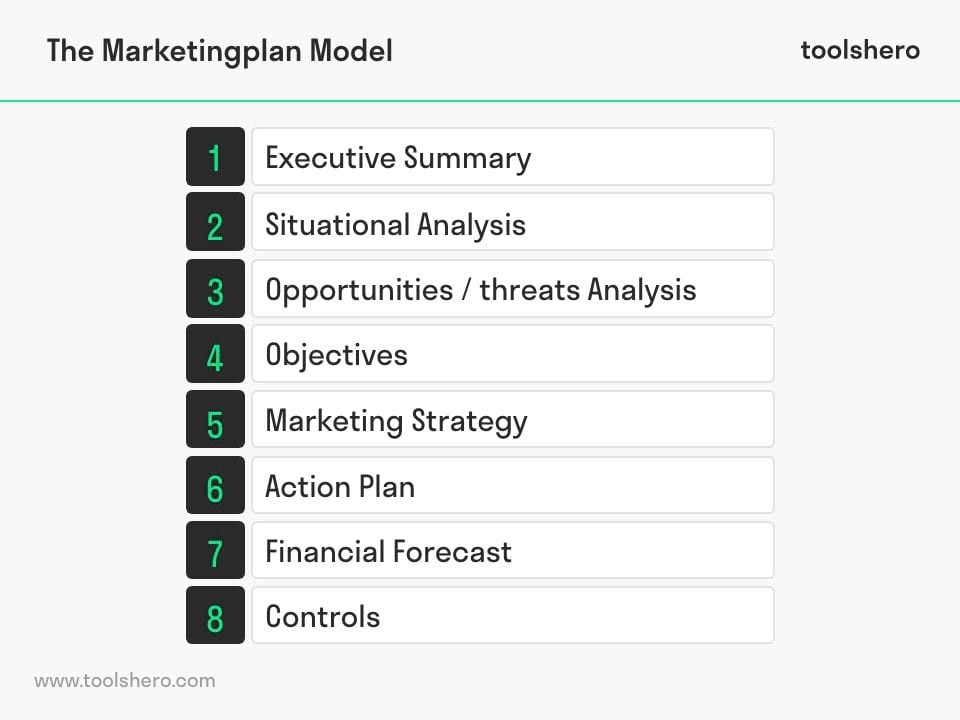Marketing Plan explained plus template

Marketing plan: this article explains the Marketing Plan in a practical way. Next to what a marketing plan is, highlights this article the core elements and a complete marketing plan template to get started. After reading it, you will understand the basics of this marketing approach. Enjoy reading!
What is a marketing plan?
A marketing plan is a strategic document that companies use to record their marketing strategy for a specific period of time. A marketing plan is likely to contain separate strategies for different marketing teams and objectives in a company, but they are all designed to support the same overarching business goal.
It can also be part of an overall business plan. In any case, a well-written plan includes a comprehensively described marketing strategy. This allows the marketing goals to be achieved.
What parts does a marketing plan consist of?
Which components are included in the plan, to a large extent, depends on its purpose and the type of organization.
The scope of a plan can be limited to some of the following if it focuses on a specific channel, such as Search Engine Optimization (SEO), social media marketing or content marketing.
- Executive summary
- Situational analyses
- Opportunities / threats (SWOT analysis)
- Marketing objectives
- Marketing strategy
- Action plan
- Financial analysis and forecasting
- Monitoring and control
The above is a summary of chapters in a general marketing plan. These components are briefly explained later in this article. In the Toolshero marketing plan template you will find in detail what should be included in an extensive marketing plan document.

Figure 1 – elements of a marketingplan
It is important to determine the purpose for which a marketing plan is drawn up in advance. Once it is clear what is to be achieved with the plan, then the relevant parts can be selected to be included in the plan.
1. Executive summary
An executive summary is a short chapter that includes a summary of the entire report. Marketing plans can be complex documents that contain a lot of detail about general marketing goals and specific activities.
It is therefore important to summarize the main points of the document and include them as the first chapter of the document.
See this chapter as an abbreviated version of the full document. The main conclusions and action points from the report must be clearly set out on 1 page.
The executive summary is the last part and is written last, but is added as the first chapter of the document.
2. Situational analyses
The first part of a plan includes the current situation and environmental factors of an organization or brand. It is important to explain this as completely as possible because it is a foundation and basis for the following elements.
The situational analysis consists of a number of components, including:
- Macro environment analysis
- Market analysis
- Customer and consumer analysis
- Internal analysis
In the template you will find in detail which matters should be included in these sections. The chapter concludes with a brief summary of the main elements.
4. Marketing objectives
The marketing objectives section is an important one. It sets out the goals for a given period and how to achieve them. Ideally, these goals are described in SMART Goals format.
In general, a marketing plan contains one or more of four types of objectives. The first of these is about boosting sales. This is by far the most pursued KPI. The second is about lead generation. In addition, increasing brand awareness is often included in the marketing objectives.
Limit the amount of goals you include in the plan. Keep these goals challenging, but achievable (SMART Objectives).
5. Marketing strategy
The marketing strategy is important because it outlines the approach to gain your competitive advantage. That may sound like a pretty simple definition, but confusion often arises when it comes to the difference between a marketing plan and a marketing strategy. As mentioned, the strategy is the plan to gain competitive advantage.
So the strategy is quite specific, where a plan is quite general. A marketing plan can contain multiple objectives and therefore multiple strategies. The strategy keeps the team aligned. The shared goals help everyone understand what is being worked towards. It helps to visualize the way there.
A marketing strategy must therefore be drawn up before actually working. Otherwise, the team works without a clear goal. To make a real impact, this strategy should not change too much in a short time. Therefore, evaluate the strategy regularly and make small changes if necessary.
Related topics that come up in the marketing strategy template section are:
- Unique Selling Proposition (USP)
- Product mix
- Product strengths and weaknesses
- Product life cycle
- Product portfolio matrix
A marketing strategy often includes the following components:
- Positioning
- Competitive environment
- Budget
- Brand Essence
- Activities
6. Action plan
A plan is used to actually execute the marketing strategy. Its purpose is to write out the objectives, strategies and other plans so that they help keep the company on track and measure progress.
Every action plan is different because it is directly linked to specific strategies and goals, but there are some elements that often come up.
Key Performance Indicators (KPIs)
Key Performance Indicators (KPIs) are essential in an action plan. These are the metrics that are used to measure the effectiveness of the marketing campaign.
Schedule and timeline
The schedule includes the key deadlines of the campaign. Meeting deadlines is important so that the campaign is not delayed and the objectives are reached on time.
Budget
Budget is often an important factor in setting up a marketing strategy. The more budget is available, the more resources such as people and financial tools can be deployed.
It is important to include budgetary considerations in the action plan so that goals and deadlines are met with the right expectations.
7. Financial analysis and forecasting of the Marketing Plan
In the end, almost everything revolves around the financial implications of the plan. The bottom line is therefore in many cases the net profit. Of course, this does not apply to non-profit organizations, where the focus is on keeping the costs contained within reasonable limits.
The following financial ratios are explained in the financial section of the plan:
- Gross profit
- Net profit
- Return on investment (ROI)
8. Monitoring and control
Their usefulness and purpose have already been explained under objectives, but goals are crucial to be able to measure progress. Marketers should be ready to update and adjust marketing plans at any time. This can only be done if progress towards the objectives is accurately measured.
Marketing Plan template
To write your Marketing Plan, you can use this ready-to-use template / worksheet in a .DOC format.
Download the Marketing Plan template
This template is exclusively for our paying Toolshero members. Click here to see if a membership is something for you!Now it’s your turn
What do you think? Do you recognize the explanation about the marketing plan? Do you have experience drafting and developing an plan? What tools and methods do you use to write it? What tips and tricks can you share for creating an effective marketing strategy? Do you have any other tips or comments?
Share your experience and knowledge in the comments box below.
More information
- Cohen, W. A. (2005). The marketing plan. John Wiley & Sons.
- Wood, M. B. (2003). The marketing plan handbook. Upper Saddle River, NJ: Prentice Hall.
- Westwood, J. (2013). How to write a marketing plan. Kogan Page Publishers.
- Chernev, A. (2020). The marketing plan handbook. Cerebellum Press.
How to cite this article:
Janse, B. (2022). Marketing Plan. Retrieved [insert date] from Toolshero: https://www.toolshero.com/marketing/marketing-plan/
Original publication date: 06/07/2022 | Last update: 01/08/2024
Add a link to this page on your website:
<a href=”https://www.toolshero.com/marketing/marketing-plan/”>Toolshero: Marketing Plan</a>












